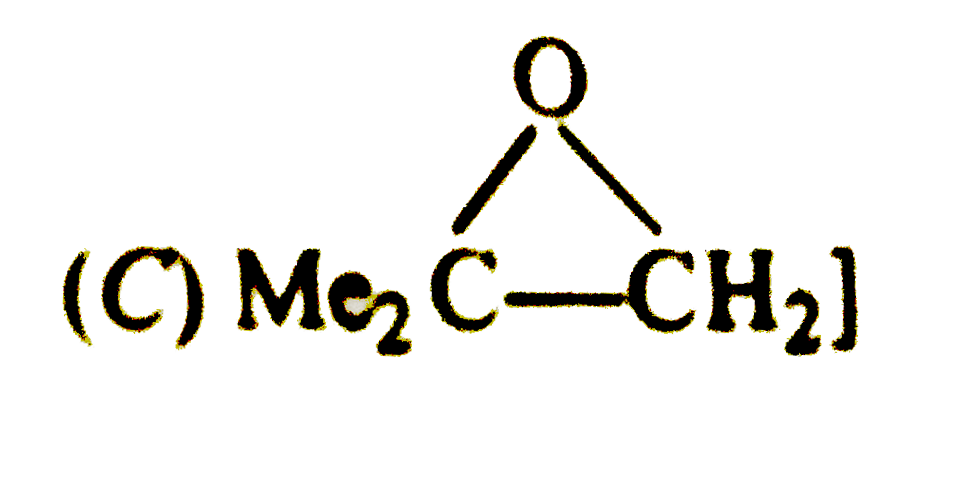CH3CHCH3∣Bralc.KOH−−−−−→AHBr−−−−→peroxideBCH3ONa−−−−−→C
In the above reaction sequence, the final product is :
diethyl ether
1-methoxypropane
isopropyl alcohol
propylene glycol
The correct Answer is:B
To solve the given reaction sequence, let's break it down step by step:
Step 1: Identify the starting compound
The starting compound is CH₃CH=CH₃ (propene with a bromine substituent at the first carbon).
Step 2: Reaction with alcoholic KOH
When propene reacts with alcoholic KOH, it undergoes an E2 elimination reaction. In this reaction, a β-hydrogen is abstracted, and bromine leaves, resulting in the formation of an alkene.
- Elimination Reaction:
- The β-hydrogen (from the second carbon) is removed by the base (KOH), and the bond between the first carbon and bromine breaks.
- This leads to the formation of propene (CH₃-CH=CH₂).
Step 3: Reaction with HBr in the presence of peroxide
Next, the alkene (propene) reacts with HBr in the presence of peroxide. According to the anti-Markovnikov rule, the hydrogen from HBr will add to the carbon with more hydrogen atoms (terminal carbon), and the bromine will add to the carbon with fewer hydrogen atoms.
- Anti-Markovnikov Addition:
- The bromine will add to the terminal carbon (CH₂), resulting in 1-bromopropane (CH₃-CH₂-CH₂Br).
Step 4: Reaction with sodium methoxide (CH₃ONa)
The final step involves the reaction of 1-bromopropane with sodium methoxide (CH₃ONa). This reaction will lead to the formation of an ether through an SN2 reaction.
- SN2 Reaction:
- The methoxide ion (CH₃O⁻) attacks the carbon bonded to bromine, displacing bromine and forming 1-methoxypropane (CH₃-CH₂-CH₂-O-CH₃).
Final Product
The final product of the reaction sequence is 1-methoxypropane.
Summary of the Steps
1. Starting compound: CH₃-CH=CH₂ (propene).
2. E2 elimination with alcoholic KOH: Forms CH₃-CH=CH₂ (propene).
3. Anti-Markovnikov addition of HBr with peroxide: Forms CH₃-CH₂-CH₂Br (1-bromopropane).
4. SN2 reaction with sodium methoxide: Forms CH₃-CH₂-CH₂-O-CH₃ (1-methoxypropane).
Final Answer:
The final product is 1-methoxypropane.
The starting compound is CH₃CH=CH₃ (propene with a bromine substituent at the first carbon).
When propene reacts with alcoholic KOH, it undergoes an E2 elimination reaction. In this reaction, a β-hydrogen is abstracted, and bromine leaves, resulting in the formation of an alkene.
- The β-hydrogen (from the second carbon) is removed by the base (KOH), and the bond between the first carbon and bromine breaks.
- This leads to the formation of propene (CH₃-CH=CH₂).
Next, the alkene (propene) reacts with HBr in the presence of peroxide. According to the anti-Markovnikov rule, the hydrogen from HBr will add to the carbon with more hydrogen atoms (terminal carbon), and the bromine will add to the carbon with fewer hydrogen atoms.
- The bromine will add to the terminal carbon (CH₂), resulting in 1-bromopropane (CH₃-CH₂-CH₂Br).
The final step involves the reaction of 1-bromopropane with sodium methoxide (CH₃ONa). This reaction will lead to the formation of an ether through an SN2 reaction.
- The methoxide ion (CH₃O⁻) attacks the carbon bonded to bromine, displacing bromine and forming 1-methoxypropane (CH₃-CH₂-CH₂-O-CH₃).
The final product of the reaction sequence is 1-methoxypropane.
1. Starting compound: CH₃-CH=CH₂ (propene).
2. E2 elimination with alcoholic KOH: Forms CH₃-CH=CH₂ (propene).
3. Anti-Markovnikov addition of HBr with peroxide: Forms CH₃-CH₂-CH₂Br (1-bromopropane).
4. SN2 reaction with sodium methoxide: Forms CH₃-CH₂-CH₂-O-CH₃ (1-methoxypropane).
The final product is 1-methoxypropane.
Similar Questions
Supply structural formulae for missing compounds.
(i) H2C=CH2+(A)→ClCH2−CH2OHH2SO4−−−−−−→413K(B)alc. KOH−−−−−−−→Δ(C)
(ii) CH3CHBrCH3alc. KOH−−−−→(A)HBr−−−−−→Peroxide(B)CH3ONa−−−−−→(C)
(iii) Me3CBralc. KOH−−−−→(A)HOCl−−−→(B)NaOH−−−→(C)

View SolutionC6H5CH2C∣BrHCH3aic.KOH−−−−−→heat?HBr−−→?
View Solution
Knowledge Check
CH3C∣BrHCH3alc./KOH−−−−−−→AHBr//peroxide−−−−−−−−→BCH3Na−−−−→C
In the above reaction sequence, the final product is:Adiethyl etherB1-methoxypropaneCisopropyl alcoholDpropylene glycolCH3C∣BrHCH3alc./KOH−−−−−−→AHBr//peroxide−−−−−−−−→BCH3Na−−−−→C
In the above reaction sequence, the final product is:Adiethyl etherB1-methoxypropaneCisopropyl alcoholDpropylene glycolIn the reaction,
CH3C∣BrHCH3alc.−−→KOHAHBr−−−−→PeroxideBCH3ONa−−−−−→C
C isAdiethyl etherB1-methoxy propaneCisopropyl alcoholDpropylene glycol.
CH3CH2CH2Clalc.KOH−−−−−→BHBr−−→CNa//ether−−−−−→D
In the above reaction, the product D is
View SolutionIn the reaction :
CH3−Br∣CH−CH3alcKOH−−−−→AHBr−−−−→PeroxideBCH3ONa−−−−−→C,C is __________
View SolutionCH3−C∣∣O−CH=CH−CH3HBr−−→
find the major product
View SolutionCH3C∣BrHCH3alc./KOH−−−−−−→AHBr//peroxide−−−−−−−−→BCH3Na−−−−→C
In the above reaction sequence, the final product is:
View SolutionPh−CH2−CH∣OH−CH3K−−→C2H5Br−−−−→(A)
Product (A) in above reaction is :
View Solution

